The Huawei Honor 5X Review: Mid-Range Meets Maturity
by Brandon Chester on February 29, 2016 8:00 AM EST- Posted in
- Smartphones
- Huawei
- Android
- Snapdragon 616
- Honor 5X
GPU Performance
There have been significant increases in smartphone performance over the past few years, and this applies to all segments of the market. While it's not entirely clear what will come after Cortex A53 in the low end and mid range segments - Snapdragon 650 currently skews towards the higher-end of the market - it's a safe bet that CPU performance will continue to improve. GPU performance has also seen improvement, but perhaps not to the same degree as CPU performance. The GPU performance of low end devices isn't quite where I'd like it to be, although hopefully this will change with Snapdragon 415's entry into the market. For the time being, GPU performance is something that separates mid range devices like the Honor 5X with its Adreno 405 GPU from lower end devices like the Moto E and even the Moto G which use Adreno 306.
Since Adreno 405 is very well known by this point, and there are fewer software related factors to influence GPU performance than CPU performance, I'm really not expecting any significant deviation from the performance of other phones with the same GPU. However, with the Honor 5X pushing a 1080p display it is interesting to see how the performance when running at native resolution is impacted when moving from a 720p to 1080p display.
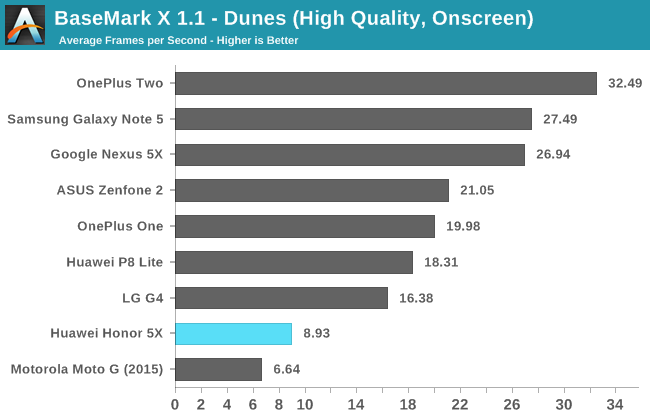
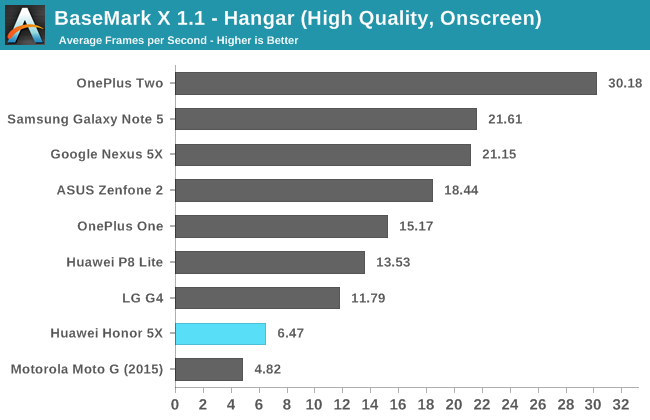
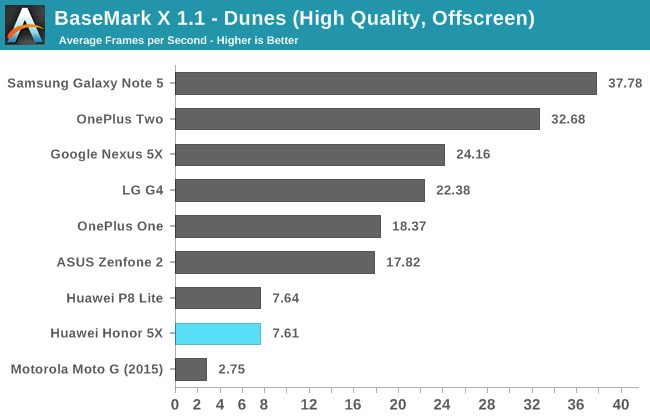
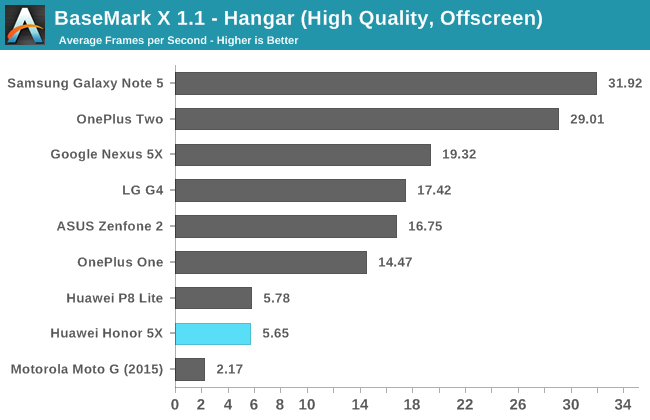
As expected, the Honor 5X tracks extremely closely with the P8 Lite in BaseMark X's off screen tests. Compared to the Moto G which uses Adreno 306 we see that the Honor 5X is roughly 2.7x faster on average, which is a very significant performance improvement.
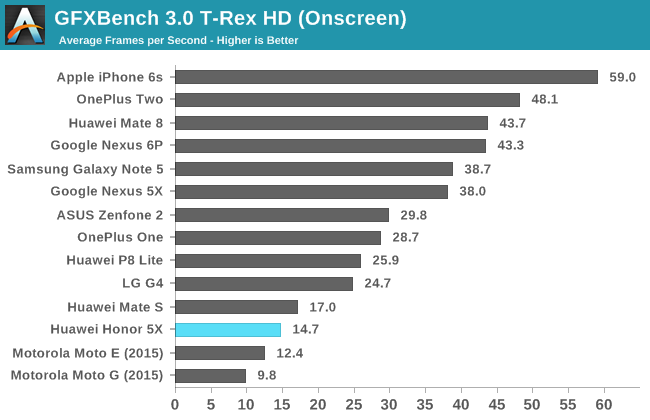

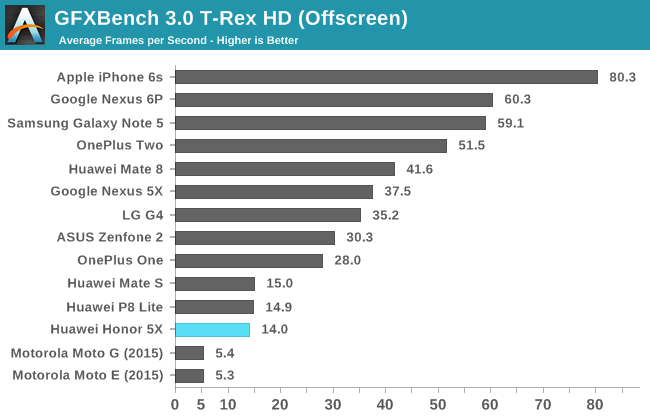
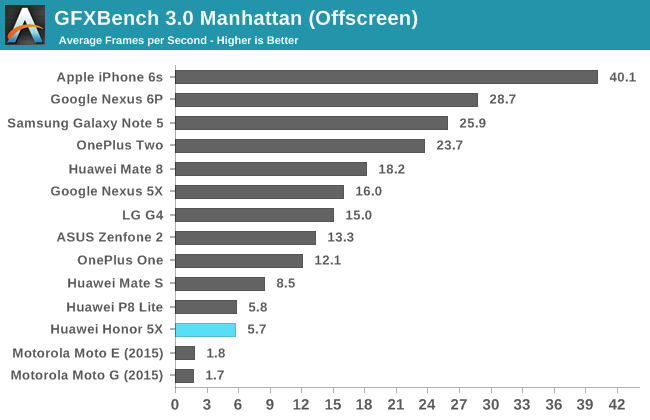
Like the results from BaseMark X, Adreno 405 performs anywhere from 2-3x better than Adreno 305/306 in GFXBench 3.0. On screen results are lower than the P8 Lite due to the Honor 5X's higher resolution display, but off screen results are essentially identical. It's worth noting that T-Rex HD is a pretty old test by now, and these mid range and low end smartphones aren't able to get anywhere close to playable frame rates at their native resolutions. Displays have definitely outpaced GPU improvements in this segment of the market, and it'll take quite a while for the GPUs to catch up.
It's interesting to note that the anomalous ASUS Zenfone 2 is still way more powerful than anything else at $200, including the Honor 5X. However, ASUS's relationship with Intel puts them in a special position, and relative to the average $200 smartphone I think the Honor 5X is about as good as it gets for GPU performance.
NAND Performance
Considering that many high end smartphones haven't moved to UFS or other high performance storage solutions, it's a safe bet that eMMC is going to stick around in mid range and low end smartphones for the foreseeable future. We've already seen how devices shipping with slower storage controllers can be bottlenecked by slow storage performance, and this is an even larger problem among less expensive smartphones where it's just not feasible to include the best NAND solution on the market. Huawei themselves has had issues with NAND performance in the past, and they've improved significantly with recent smartphones, so one would hope that this holds true for the Honor 5X as well.
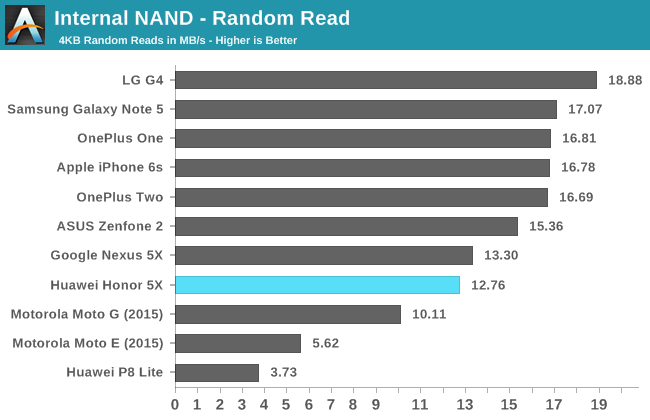
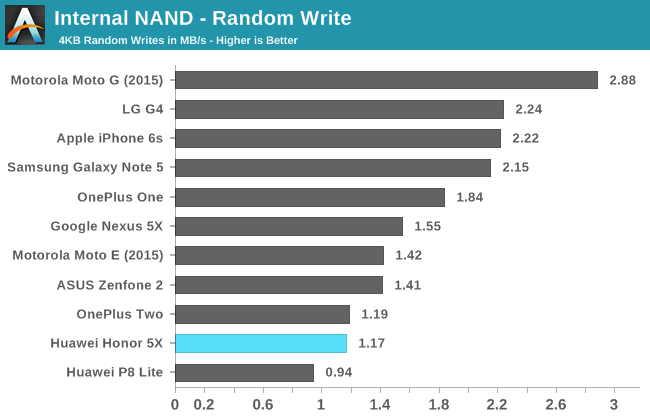

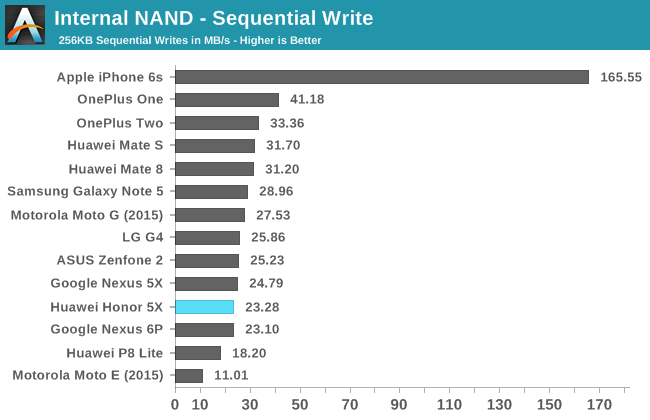
The Honor 5X's NAND performance is in line with what you get from other low end and mid range smartphones. You can't really expect mind blowing NAND performance from these devices, but one can hope that we're at the point where the NAND is fast enough to not be the bottleneck in the system. There's significant improvements across the board compared to the P8 Lite, which is good to see as the P8 Lite performed extremely poorly for a $250 device. I think many of these mid range devices could stand to improve on random write speeds, but that's a more general discussion for another time.










30 Comments
View All Comments
UtilityMax - Thursday, March 3, 2016 - link
Indeed. If the device is mid-range, shouldn't it be at least competitive with a three year old flagship SoC, such as the Snapdragon 800? Looking at the benchmarks, SD800 is still much faster at least in single threaded benchmarks. But the market "has spoken". We "need" 64-bit and eight cores they said..LiverpoolFC5903 - Tuesday, March 1, 2016 - link
I'd like to see the A53s clocked much higher (2.2-2.5 ghz) in mid range chipsets to make it competitive with previous gen Snapdragon 800 socs. SIngle threaded performance is still very critical in terms of javascript performance. A high clocked A53 based soc with dual channel RAM and a decent GPU is more than enough for most applications.UtilityMax - Thursday, March 3, 2016 - link
My thought too. Come on people. The Snapdragon 800 is three years old. Can't we have that level of performance in at least in a midrange smartphone these days? Instead, we see "midrange" devices with SoC performance that's about on the level with the original iPhone 5.LiverpoolFC5903 - Thursday, March 3, 2016 - link
Last years 'mid range' Qualcomm chipsets were laughably underpowered. Hell , my 3 year old Optimus G Pro with a 1.7ghz Snapdragon 600 and Adreno 320 2nd gen GPU is STILL faster than Snapdragon 615 phones. Dual channel memory and GPU makes a LOT of difference to the overall 'feel' and usability of a smartphone. And obviously single threaded performance, which is very important in day to day user experience, needs to be at least at the Snapdragon 800/801 range in 2016.zodiacfml - Sunday, March 6, 2016 - link
Right. There are some phones still available with those chips previous the 810 for a near mid-range price.mmsmsy - Tuesday, March 1, 2016 - link
How about Xiaomi Redmi Note 3 with Mediatek X10 or the Pro version with Snapdragon 650? In my opinion way more important phone to review that this one.LiverpoolFC5903 - Tuesday, March 1, 2016 - link
I dont believe Anandtech have done a review of ANY phone with the Helio X10. Would love to see a detailed analysis of that chipset, especially compared to erstwhile flagship socs from the 800 series.Badelhas - Tuesday, March 1, 2016 - link
True.But what I really want to see is AnandTech reviewing the HTC VIVE! :)
Ryan Smith - Tuesday, March 1, 2016 - link
It's on my list of things I want to do.=)LukaP - Tuesday, March 1, 2016 - link
Hell the Mi4c is only a bit more expensive than this, and offers a S808 and otherwise pretty high end specs... This is a decisively lowend device.